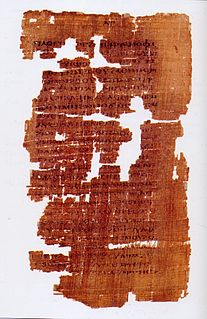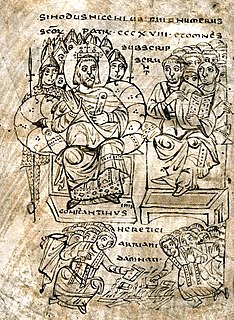
Gnosticism is a collection of religious ideas and systems which coalesced in the late 1st century AD among Jewish and early Christian sects. These various groups emphasised personal spiritual knowledge (gnosis) above the orthodox teachings, traditions, and authority of religious institutions. Viewing material existence as flawed or evil, Gnostic cosmogony generally presents a distinction between a supreme, hidden God and a malevolent lesser divinity who is responsible for creating the material universe. Gnostics considered the principal element of salvation to be direct knowledge of the supreme divinity in the form of mystical or esoteric insight. Many Gnostic texts deal not in concepts of sin and repentance, but with illusion and enlightenment.

Irenaeus was a Greek bishop noted for his role in guiding and expanding Christian communities in the southern regions of present-day France and, more widely, for the development of Christian theology by combating heresy and defining orthodoxy. Originating from Smyrna, he had seen and heard the preaching of Polycarp, who in turn was said to have heard John the Evangelist, and thus was the last known living connection with the Apostles.

Ebionites as a term refers to a Jewish Christian sect who were vegetarians, viewed poverty as holy, believed in ritual ablutions, and rejected animal sacrifices. They existed during the early centuries of the Common Era. The Ebionites embraced an adoptionist Christology, thus understanding Jesus of Nazareth as a mere man who, by virtue of his righteousness, was chosen by God to be a true prophet. A majority of the Ebionites rejected as heresies the proto-orthodox Christian beliefs in Jesus's divinity and virgin birth. They maintained that Jesus was the natural son of Joseph and Mary who became the Messiah because he obeyed the Jewish law.

In Islam,ʿĪsā ibn Maryam, is the penultimate prophet and messenger of God (Allah) and the Messiah, who was sent to guide the Children of Israel with a revelation: Injīl.
According to the Panarion of Epiphanius of Salamis, and Theodoret's Haereticarum Fabularum Compendium, the Borborites or Borborians were a Christian Gnostic sect, said to be descended from the Nicolaitans. It is difficult to know for sure the practices of the group, as both Epiphanius and Theodoret were opponents of the group. According to Epiphanius, the sect were libertines who embraced the pleasures of the earthly world. The word Borborite comes from the Greek word βόρβορος, meaning "mud"; the name Borborites can therefore be translated as "filthy ones", and is unlikely to be the term the sect used for themselves.

Marcion of Sinope was an early Christian theologian, an evangelist, and an important figure in early Christianity. Marcion preached that the benevolent God of the Gospel who sent Jesus Christ into the world as the savior was the true Supreme Being, different from and opposed to the malevolent demiurge or creator god, identified with the Hebrew God of the Old Testament. He considered himself a follower of Paul the Apostle, whom he believed to have been the only true apostle of Jesus Christ, a doctrine called Marcionism. Marcion published the earliest extant fixed collection of New Testament books.

Epiphanius of Salamis was the bishop of Salamis, Cyprus at the end of the 4th century. He is considered a saint and a Church Father by both the Eastern Orthodox and Roman Catholic Churches. He gained a reputation as a strong defender of orthodoxy. He is best known for composing the Panarion, a very large compendium of the heresies up to his own time, full of quotations that are often the only surviving fragments of suppressed texts. According to Ernst Kitzinger, he "seems to have been the first cleric to have taken up the matter of Christian religious images as a major issue", and there has been much controversy over how many of the quotations attributed to him by the Byzantine Iconoclasts were actually by him. Regardless of this he was clearly strongly against some contemporary uses of images in the church.
The Ophites, also called Ophians, were a Christian Gnostic sect depicted by Hippolytus of Rome (170–235) in a lost work, the Syntagma ("arrangement").
Cerinthus was an early Gnostic, who was prominent as a heresiarch in the view of the early Church Fathers. Contrary to the Church Fathers, he used the Gospel of Cerinthus, and denied that the Supreme God made the physical world. In Cerinthus' interpretation, the Christ descended upon Jesus at baptism and guided him in ministry and the performing of miracles, but left him at the crucifixion. Similarly to the Ebionites, he maintained that Jesus was not born of a virgin, but was a mere man, the biological son of Mary and Joseph.
Valentinus was the best known and, for a time, most successful early Christian Gnostic theologian. He founded his school in Rome. According to Tertullian, Valentinus was a candidate for bishop but started his own group when another was chosen.

The Infancy Gospel of Thomas is a biographical gospel about the childhood of Jesus, believed to date at the latest to the second century. The Infancy Gospel of Thomas was thought to be Gnostic in origin because of references to a "Gospel of Thomas", but those works are not referencing this Infancy Gospel, as many scholars had thought, but rather to the wholly different Gospel of Thomas.
The Cainites, or Cainians, were a Gnostic and Antinomian sect known to venerate Cain as the first victim of the Demiurge, the deity of the Old Testament, who was identified by many groups of Gnostics as evil. The sect following was relatively small. They were mentioned by Tertullian and Irenaeus as existing in the eastern Roman Empire during the 2nd century. One of their purported religious texts was the Gospel of Judas.

The New Testament apocrypha are a number of writings by early Christians that give accounts of Jesus and his teachings, the nature of God, or the teachings of his apostles and of their lives. Some of these writings have been cited as scripture by early Christians, but since the fifth century a widespread consensus has emerged limiting the New Testament to the 27 books of the modern canon. Roman Catholic, Eastern Orthodox, and Protestant churches generally do not view these New Testament apocrypha as part of the Bible.
The Basilidians or Basilideans were a Gnostic sect founded by Basilides of Alexandria in the 2nd century. Basilides claimed to have been taught his doctrines by Glaucus, a disciple of St. Peter, though others stated he was a disciple of the Simonian Menander.
The Gospel of Eve is an almost entirely lost text from the New Testament apocrypha, which may be the same as the also lost Gospel of Perfection.
The Sethians were one of the main currents of Gnosticism during the 2nd and 3rd century CE, along with Valentinianism and Basilideanism. According to John D. Turner, it originated in the 2nd-century CE as a fusion of two distinct Hellenistic Judaic philosophies and was influenced by Christianity and Middle Platonism. However, the exact origin of Sethianism is not properly understood.

Esoteric Christianity is an approach to Christianity which features "secret traditions" that require an initiation to learn or understand. The term esoteric was coined in the 17th century and derives from the Greek ἐσωτερικός.

Traditionally in Christianity, orthodoxy and heresy have been viewed in relation to the "orthodoxy" as an authentic lineage of tradition. Other forms of Christianity were viewed as deviant streams of thought and therefore "heterodox", or heretical. This view was challenged by the publication of Walter Bauer's Rechtgläubigkeit und Ketzerei im ältesten Christentum in 1934. Bauer endeavored to rethink Early Christianity historically, independent from the views of the current church. He stated that the 2nd-century church was very diverse and included many "heretical" groups that had an equal claim to apostolic tradition. Bauer interpreted the struggle between the orthodox and heterodox to be the "mainstream" Church of Rome struggling to attain dominance. He presented Edessa and Egypt as places where the "orthodoxy" of Rome had little influence during the 2nd century. As he saw it, the theological thought of the "Orient" at the time would later be labeled "heresy". The response by modern scholars has been mixed. Some scholars clearly support Bauer's conclusions and others express concerns about his "attacking [of] orthodox sources with inquisitional zeal and exploiting to a nearly absurd extent the argument from silence." However, modern scholars have critiqued and updated Bauer's model.

Infancy gospels are a genre of religious texts that arose in the 2nd century. They are part of New Testament apocrypha, and provide accounts of the birth and early life of Jesus. The texts are of various and uncertain origin, and are generally non-canonical in major modern branches of Christianity. They include the Gospel of James, which introduces the concept of the Perpetual Virginity of Mary, and the Infancy Gospel of Thomas, both of which cover many miraculous incidents from the life of Mary and the childhood of Jesus that are not included in the canonical gospels. Although the Life of John the Baptist focuses on John the Baptist rather than Jesus or his immediate family, it is also included in the genre as its events would be contemporary with Jesus's early life.









